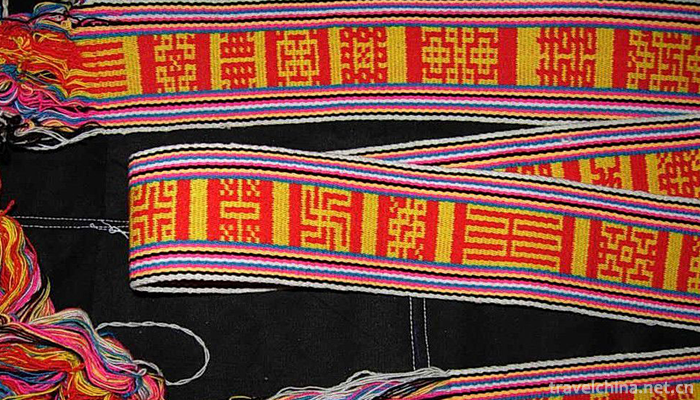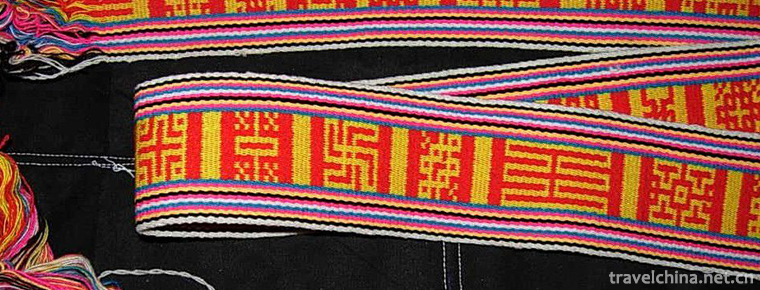Qiang embroidery
Qiang embroidery
Qiang embroidery evolved and developed on the basis of inheriting the ancient Qiang people's embroidery. Mainly distributed in Wenchuan County, two towns and four townships (Mianfu Town, Weizhou Town, Longxi Township, Keku Township, Yanmen Township, Caopo Township) embroidery needle method in addition to the use of pick flowers, there are Nahua, fibre, chain buttons and peace embroidery. The themes of Qiang embroidery patterns mostly reflect the natural scenery in real life, such as flowers and fruits in plants, deer, lion, immune, insects, fish, birds, and characters in animals, etc. .
On June 7, 2008, Qiang embroidery was selected into the second batch of national intangible cultural heritage list with the approval of the State Council.
historical origin
The source of Qiang embroidery is different. Folk people have a legend about flower-picking embroidery: Before the Three Kingdoms, Qiang women were able to fight well. Kong Ming sent Jiang Wei to Wenshan and was repeatedly defeated by Qiang women. Later, Kong Ming used charms to form flower-picking waistbands and gave them to Qiang women. Qiang women are competing to follow suit, and the flower-picked waistband has spread among them. Who knows, the inscriptions painted by Kong Ming on the waistband captivate the heart of Qiang women, and from then on, Qiang women will not fight for tactics, only knows how to pick flowers and embroidery. Legend is not credible, but stripping the mysterious clothes of this legend, we can see that Qiang embroidery art was originally introduced from the Han Dynasty. However, this kind of flower-picking art has been rooted in the Qiang people for a long time. Through the practice and refinement of life, it not only absorbs the basic stitching elements of the Han people's flower-picking embroidery, but also inherits the tradition of the ancient Qiang culture. Its composition and pattern have already possessed the national style and characteristics of the Qiang people and become the unique art treasure of the Qiang people.
About Qiang Embroidery
The Qiang people are a very wise people, but also a people who advocate beauty. Beauty and art originate from labor. It is also because people create objective objects with preliminary formal beauty in labor that symmetry and smoothness of aesthetic conception can be produced accordingly. Qiang embroidery is bright and exquisite, which not only shows the wisdom and wisdom of Qiang women, but also expresses the desire of Qiang people to advocate beauty. Labor creates beauty: beauty of labor products, beauty of labor tools, beauty of labor movements, beauty of art created by labor. After thousands of years of inheritance and development, Qiang embroidery seems to have condensed the essence of history, and has formed a fine embroidery with unique style. It has gradually been recognized as the embroidered handicraft of the same name as Xiang embroidery and Suzhou embroidery, and has become a wonderful work in the treasures of Chinese culture.
Nowadays, Qiang embroidery has already become an important part of Qiang people's clothing. Qiang's clothes are simple and beautiful. Men prefer blue or white headdresses, wear homemade linen long shirts and a sleeveless sheepskin jacket, which can be used for cold protection, rain protection and cushioning. Cloud shoes with nose are worn on the feet. Cloud patterns and ripples are embroidered on the shoes. Feet are bound with blankets made of cows and wool. Leg binding has the function of heat preservation and leg protection. Women like to wrap blue or white headkerchiefs. Young women often embroider headkerchiefs with various patterns or fold them on their heads with tiled green cloth and use two hair braids to wrap their hair around their temples. In winter, they usually wrap square headkerchiefs and embroider various patterns. In spring and autumn, they wrap embroidered headkerchiefs, wear laced clothes, wear embroidered headkerchiefs around their waists and tie flowing ribbons with laces. Young women still wrapped red foot bands around their feet and legs. Both men and women wear belts. Qiang embroidery has decorative patterns, which can be seen everywhere in the waistbands, skirts, aprons and shoes of the Qiang people, or in women's headdresses, cuffs, skirts, even socks and insoles. Qiang embroidery not only has complete structure, prominent image, brilliant color, exquisite workmanship, and plays an aesthetic role, but also with the help of the dense pins and pins, it enhances the wear resistance of the wearable parts of clothing, prolongs its service life and has practical value. Marx thought: "Animals can only be constructed according to the scale and needs of the species to which they belong, while people know how to produce according to the scale of any species, and how to apply the internal scale to the object everywhere, so people also construct according to the law of beauty." Qiang embroidery is not only a simple ornament, but also an art with unique national characteristics. It has been deeply integrated into the lives of the Qiang people. It is an important symbol of a woman's intelligence and wisdom. It is an important way for them to beautify themselves and express their feelings and wishes. It is also often a love letter for young men and women to express their good love. It integrates art and practice, and is the materialization and symbol of Qiang people's pursuit of truth, goodness and beauty.
Heritage figures
Protection Unit: Wenchuan County Cultural Museum, Aba Tibetan and Qiang Autonomous Prefecture
Maoxian Cultural Museum, Aba Tibetan and Qiang Autonomous Prefecture
National Heritage: Wang Guofang
Provincial successors: Wang Sifang and Chen Pingying
Inheritance Significance
Qiang embroidery is the crystallization of the Qiang people's labor and wisdom, and it is closely related to the specific historical conditions, living environment and religious beliefs of the Qiang people. It highlights the strong artistic creativity and aesthetic taste of the Qiang people, and is the cultural carrier of the Qiang people's thoughts, feelings, aspirations and ideals. Today, with the increasing voice of economic and cultural industries, the inheritance and development of Qiang embroidery is of great significance to further understand the history and culture of the Qiang people, to understand the folk arts of the Qiang people and to revitalize the economic development of the Qiang area.
Other correlations
Qiang embroidery is a provincial intangible cultural heritage. Qiang embroidery is an ordinary needlework of Qiang women in their leisure time. It develops and innovates constantly in the oral instruction of their elders. Women have their own skills. Especially in the process of flower-picking embroidery, patterns and styles are in their hearts. Therefore, they neither proofing nor drawing lines. Only five-color silk, cotton and wool thread, with skilled skills, can embroider various patterns with national style and gorgeous colors, which are vivid and vivid. The types and themes of the patterns mainly reflect the life or natural scenery of the Qiang people, and the embroidered objects are beautiful, delicate and full of implications. The pattern has bright colors, unique shapes, plain and lovely images and unique styles, reflecting the desire of the Qiang people for a happy life and a bright future. Yunyun shoes and embroidered waistband are the most representative crafts in Qiang embroidery. Others include Tibetan bags, bags, hats, shuttles, felt, mattresses, wall hangings and so on. They are also exquisite .


-
1.Xingwen sea
Xingwenshihai is located in Xingwen County, Yibin City, Sichuan Province. It is located in the transition zone between Sichuan Basin and Yunnan-Guizhou Plateau. Its total area is about 156 square kilo
Time 2018-12-24 -
2.Huang Sha ancient ferry
The original eco-tourism scenic spot of Huangsha Gudu is one of the eight scenic spots of Ningxia in Ming and Qing Dynasties, including the national AAAA-level tourism scenic spot, the National Wetlan
Time 2019-01-18 -
3.Lao Leshan Tourist Scenic Spot
Lao Leshan is located in the south of Henan Province, 9 kilometers southwest of Zhumadian City and 8 kilometers west of Queshan County. National Highway 107
Time 2019-01-29 -
4.Chagan Sulide Festival
Sulide, in Mongolian, has the meaning of auspiciousness, loftiness, harmony, unity and harmony. The sacrifice of Chagan Sulide is the natural worship of the universe of heaven and earth gradually form
Time 2019-04-15 -
5.Legend of Liu Bowen
Liu Bowen's legend is based on the traditional folk oral literature of Liu Ji, a historical figure, spread throughout the whole country in eastern Zhejiang, with Qingtian, Wencheng and other southern
Time 2019-05-13 -
6.Sugar plastic
Sugar sculpture, one of the traditional folk handicraft products, commonly known as sugar blowing, sugar manikin, engaged in this trade called sugar blowing people, throughout the country, especially
Time 2019-06-18 -
7.a type of Shaanxi Opera popular in the Weinan Dali region
Bowl-bowl tune is one of the local operas in Shaanxi Province, also known as "lamp-bowl tune" and "Ruan'er tune". The former is named for the main rhythm of the small copper bowl a
Time 2019-06-25 -
8.Production Techniques of Dahongpao of Wuyi Rock Tea
Wuyi Rock Tea (Dahongpao) production technology, local traditional handicraft in Wuyishan City, Fujian Province, one of the national intangible cultural heritage.
Time 2019-06-30 -
9.Yao Peoples Playing Hall
The Playing Hall is a folk grand gathering of memorizing ancestors, recalling history, celebrating harvest, rewarding vows, disseminating knowledge and mass entertainment activities in Liannan Paiyao.
Time 2019-07-11 -
10.Capital Medical University
Capital Medical University (Capital Medical University), known as the first Medical University, is jointly established by the Beijing Municipal People's government, the national health and Health Comm
Time 2019-11-26 -
11.Daofu steamed bun with beef and mutton
Steamed bun with beef and mutton is a special traditional delicious food of Hui nationality. It is famous at home and abroad for its strict selection of materials, cooking essence, rich nutrition and mellow taste. The eating method of beef and mutton steamed
Time 2020-12-06 -
12.Dazhous tertiary industry
In 2019, the total retail sales of social consumer goods in Dazhou city will reach 98.794 billion yuan, an increase of 11.0%, 0.6 percentage points higher than that of the whole province, ranking the fourth in the province. From the regional perspectiv
Time 2020-12-20